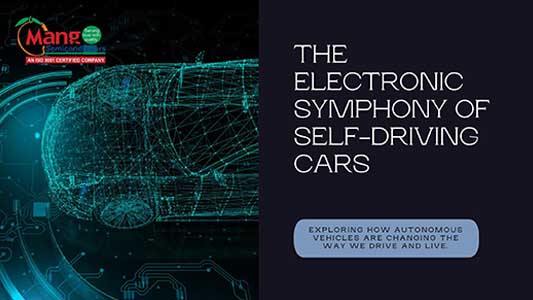Imagine a world where commutes are stress-free, traffic jams a thing of the past, and road accidents become a rarity. This futuristic vision is inching closer to reality thanks to the marvel of autonomous vehicles (AVs). But have you ever wondered what goes on beneath the sleek hood of a self-driving car? It’s not magic, but a complex orchestra of electronic components working in harmony.
Unlike traditional vehicles driven by human intuition, AVs rely on a sophisticated electronic nervous system to perceive their surroundings, make decisions, and navigate the roads. This blog delves into the key players in this electronic symphony, the components that orchestrate the safe and smooth operation of autonomous vehicles.
The Sensory Symphony: Seeing and Feeling the Road
The first act of the AV play involves a multitude of sensors, acting as the eyes and ears of the vehicle. These sensors gather real-time data about the surrounding environment, feeding a constant stream of information to the processing unit, the conductor of the electronic orchestra.
- High-Resolution Cameras: Imagine a car with super-powered vision. Unlike regular car cameras, AVs use high-resolution cameras that capture details like traffic lights, lane markings, and even pedestrians crossing the road. These high-fidelity cameras work much like the ones you have on your smartphone, but with superior resolution and processing power to ensure clear visuals even in challenging lighting conditions.
- LiDAR: The 3D Mapping Maestro: LiDAR (Light Detection and Ranging) is a sophisticated sensor that uses laser beams to create a highly detailed 3D map of the environment. Imagine a car that can not only see its surroundings but can also build a three-dimensional model of the road, buildings, and objects around it. This 3D map is crucial for the AV to understand the layout of the environment and plan its route accordingly.
- Radar: The All-Weather Watchman: While cameras struggle in low-light conditions, radar provides unwavering vigilance. Radar uses radio waves to detect the presence, speed, and direction of objects around the vehicle, even in fog, rain, or snow. This allows the AV to maintain a safe distance from other vehicles and avoid obstacles even when visibility is limited.
- Ultrasonic Sensors: The Close-Proximity Chorus: These are the short-range specialists of the sensor world. Perfect for parking maneuvers or navigating tight spaces, ultrasonic sensors emit sound waves and measure their echo to detect nearby objects. They act like a virtual bubble around the car, alerting the system to any immediate obstacles.
The Processing Powerhouse: Making Sense of the Sensory Symphony
- The data collected by the sensors is like a jumble of notes. To create a coherent melody, we need a powerful processor to analyze and interpret this information. This is where the Central Processing Unit (CPU) and Graphics Processing Unit (GPU) come into play.
- The Maestro: The Central Processing Unit (CPU): The CPU acts as the main conductor of the electronic orchestra. It receives the data from all the sensors, coordinates the various systems within the vehicle, and makes real-time decisions about steering, braking, and acceleration. Imagine a powerful computer specifically designed for the demands of autonomous driving, constantly juggling information and making critical choices.
- The Image Processing Virtuoso: The Graphics Processing Unit (GPU): While the CPU oversees the entire operation, the GPU is a specialist in image processing. Tasks involving deep learning algorithms, crucial for object recognition and scene understanding, are efficiently handled by the GPU. It’s like having a dedicated graphics card within the car, specifically designed to analyze the visual data captured by the cameras and make sense of the surroundings.
- Specialized Chips: The Supporting Cast: Sometimes, the complexity of deep learning algorithms requires additional processing power. This is where specialized chips like Neural Network Processors (NNPs) come into play. These chips are designed to accelerate specific calculations, allowing the AV to make decisions even faster and more efficiently. Think of them as specialist musicians brought in to handle particularly demanding sections of the musical piece.
Keeping the Music Going: Essential Electronic Components for AVs
Beyond the core sensory and processing units, several other electronic components play vital roles in the smooth operation of AVs.
- Global Positioning System (GPS): The GPS acts like a digital map and compass, providing the vehicle’s location and constantly updating its position within the environment. This ensures the AV knows exactly where it is and can correlate that information with the sensory data to navigate accurately.
- Inertial Measurement Unit (IMU): This component measures the vehicle’s acceleration and angular velocity, providing valuable information about its motion. Imagine a high-tech set of internal gyroscopes and accelerometers constantly feeding data on how the car is moving, tilting, and turning.












